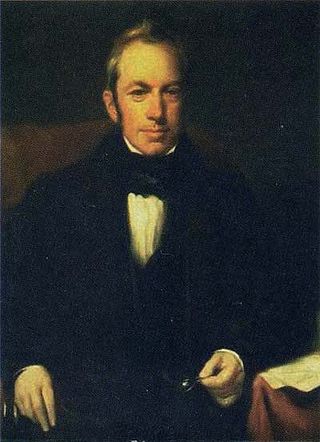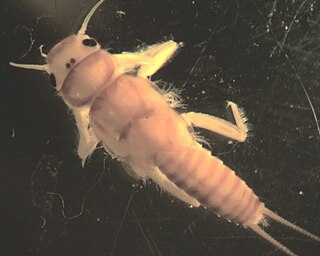
Robert Brown was a Scottish botanist and paleobotanist who made important contributions to botany largely through his pioneering use of the microscope. His contributions include one of the earliest detailed descriptions of the cell nucleus and cytoplasmic streaming; the observation of Brownian motion; early work on plant pollination and fertilisation, including being the first to recognise the fundamental difference between gymnosperms and angiosperms; and some of the earliest studies in palynology. He also made numerous contributions to plant taxonomy, notably erecting a number of plant families that are still accepted today; and numerous Australian plant genera and species, the fruit of his exploration of that continent with Matthew Flinders.

The brown palm civet, also called the Jerdon's palm civet, is a viverrid endemic to the Western Ghats of India.

The Canary long-eared bat, also known as the Canary big-eared bat or Tenerife long-eared bat, is a species of vesper bat endemic to the Canary Islands. According to the IUCN, it is critically endangered. It feeds mainly on moths. Roosting sites include caves, lava tubes and abandoned buildings.

The Perlidae are a family of stoneflies, with more than 50 genera and 1,100 described species. The majority of the Perlidae are found in eastern North America, but they occur worldwide except for Antarctica and parts of Africa. Their lifecycles range between one and three years. The adults emerge in the summer; they are very active and known to be attracted to light sources. They are usually very sensitive to changes in environment.

The flora of Western Australia comprises 10,842 published native vascular plant species and a further 1,030 unpublished species. They occur within 1,543 genera from 211 families; there are also 1,335 naturalised alien or invasive plant species more commonly known as weeds. There are an estimated 150,000 cryptogam species or nonvascular plants which include lichens, and fungi although only 1,786 species have been published, with 948 algae and 672 lichen the majority.

Dinocras ferreri is a species of stonefly belonging to the family Perlidae.

Neoperla nigromarginata is a species of stonefly native to the Henan province of China. The forewing measures 11.8 millimeters in males, and 13.4–14.0 millimeters in females. The head is pale yellow to brown with black markings. Legs and antennae are brown. The species name refers to the dark-colored margins of the pronotum. The species is similar in many aspects to Neoperla flagellate and N. tuberculata, but can be distinguished by the size of the aedeagus. The Aedeagal sac and tube are approximately the same length, with the sac being membranous and covered in numerous small spines. A pair of flagella are discernable at the sac's apex.

Acroneuria internata is a species of stonefly in the family Perlidae. The scientific name of this species was first published 1852 by Walker.
Claudio Gilberto Froehlich was a Brazilian zoologist.

Hesperoperla hoguei, the banded stone, is a species of common stonefly in the family Perlidae. It is found in North America.

Acroneuria abnormis, the common stone, is a species of common stonefly in the family Perlidae. It is found in North America.

Acroneuria is a genus of common stoneflies in the family Perlidae. There are more than 30 described species in Acroneuria.

Neoperla is a genus of common stoneflies in the family Perlidae. There are more than 260 described species in Neoperla.

Perlinella is a genus of common stoneflies in the family Perlidae. There are at least three described species in Perlinella.

Perlinella drymo, the striped stone, is a species of common stonefly in the family Perlidae. It is found in North America.

Neoromicia robtertsi is a species of vesper bat found in Madagascar. It is a recently described species, as it was first described in 2012.

Orcés’s long-tongued bat is a species of leaf-nosed bat found in Ecuador.

Kalko's round-eared bat is a species of leaf-nosed bat endemic to Panama.
Burton's yellow-shouldered bat is a species of leaf-nosed bat found in Panama and Costa Rica.

Stenoperla prasina is a species of stonefly belonging to the family Eustheniidae. This species is endemic to New Zealand and is classified as "Not Threatened" under the New Zealand Threat Classification System. It is found on the North, South and Stewart Island / Rakiura Islands as well as on Little Barrier Island. Although adults of this species are most often coloured bright green, this species can be coloured yellow. This species inhabits clean, cold, running streams and rivers with stony bottoms within native bush. It is a known indicator of water quality. The larvae eat plant detritus and other aquatic insects while the adult insects feed on sooty mould fungi as well as other plant matter. The adults of this species are a known food source for New Zealand long tailed bats. Adults have been dissected and have been found to have been carrying Nematomorpha and trematode parasites. The New Zealand Department of Conservation classifies this species as "Not Threatened". In 2022 a specimen of this species was the 5 millionth specimen to be digitised in the Natural History Museum, London collection.















